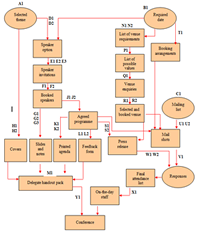PRINCE2 - Product-based planning part 4
of the Cabinet Office under delegated authority from the Controller of HMSO.
Creating a Product Flow Diagram
This is the last task in Product-based planning.
It derives from the Product Breakdown Structure and indicates the order of product creation.
All products are indicated by a rectangle in the Product Flow Diagram.
Arrows indicating the flow of creation join the rectangles.
Existing products or those not under the direct control of the Project Manager would be indicated by an ellipse.
The flow diagram will start with any necessary available products and end with the final product.
Should the act of producing the Product Flow Diagram indicate new products these must be added to the Product Breakdown Structure and a Product Description written for each one.
In a similar fashion to the Product Descriptions the Project or Team Manager should involve those who may have an interest to help in putting together the flow diagram.
The flow diagram (see conference example to the right) will contain 'specialist products' and ‘management products’ [see Change control - technique].
For simplicity it is better to put the flow diagram together containing firstly the ‘specialist products’ and then to add in the ‘management products’ that relate to these.
Many people find it easier to produce the flow diagram by starting with the final product and asking, ‘What products are required to achieve this?’
Any stage ends should coincide with any Project Board approvals that may exist.
The Product Description can help with dependencies and there is a section, called ‘derivation’, requiring you to answer the question, ‘Where do I get the information from?’. Knowing this answer will provide some guide for dependencies.
Key criteria
- On what products is each product dependent?
- Is this dependency linked to a product external to the project scope and the Project Manager’s direct control?
- What products can be developed in parallel?
- Have any new / previously unidentified products come to light?
Steps
These steps summarise the ‘hints and tips’ in ‘Managing successful projects with PRINCE2®, 2005 edition’ and in addition may cross refer to sections of the appropriate Product Description outlines.
- As with the Product Breakdown Structure the final product goes at the top of the hierarchy.
- Moving backwards, consider the immediate products that must be put in place before the final product can be created and add them.
- In turn consider what products must be in place to create these products.
- Add any pre-existing products at the start of the diagram.
- Then add the products that should immediately follow these.
- Add other planned products that do not need a predecessor.
- Study all of the products at the start of the flow diagram for any forgotten predecessors. If you identify any add them to the flow diagram and to the Product Breakdown Structure.
- Compare pairs of unallocated products in the Product Breakdown Structure and decide if there is any link between them.
- Compare these products to the products already in the Product Flow Diagram and decide what sequence there is between them.
- Compare for any unallocated external products in the Product Breakdown Structure and decide which products in the plan needs them.
- Ensure that any integration products are included in the sequence after their simple products.
- Ensure that any collective groupings are transferred to the flow diagram.
- Check each product in the flow diagram against the other ‘branches’ for interdependency.
- Is any product dependent on another product that is not in the flow diagram. If so, add it and also add it to the Product Breakdown Structure.
- Decide if it needs a Product Description.
- Arrows should connect all dependencies.
- Check the naming convention across the Product Breakdown Structure, Product Flow Diagram and the Product Description.
- Check all products to make sure that all dependencies have been identified.
As you tackle each stage the Stage Plan is likely to contain a little more detail compared to the overall Project Plan.
Again, make sure that product naming is consistent.
Managing Successful Projects with PRINCE2 - 2005 edition
Managing successful Projects with PRINCE2 – 2009 edition
Directing Projects with PRINCE2.
plus:
The Complete Project Management package.
And much more besides - at a fantastic price.



